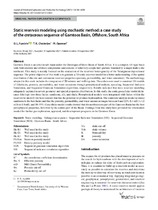| dc.description.abstract | Gamtoos Basin is an echelon sub-basin under the Outeniqua ofshore Basin of South Africa. It is a complex rift-type basin
with both onshore and ofshore components and consists of relatively simple half-grabens bounded by a major fault to the
northeast. This study is mainly focused on the evaluation of the reservoir heterogeneity of the Valanginian depositional
sequence. The prime objective of this work is to generate a 3D static reservoir model for a better understanding of the spatial
distribution of discrete and continuous reservoir properties (porosity, permeability, and water saturation). The methodology
adopted in this work includes the integration of 2D seismic and well-log data. These data were used to construct 3D models
of lithofacies, porosity, permeability, and water saturation through petrophysical analysis, upscaling, Sequential Indicator
Simulation, and Sequential Gaussian Simulation algorithms, respectively. Results indicated that static reservoir modeling
adequately captured reservoir geometry and spatial properties distribution. In this study, the static geocellular model delineates lithology into three facies: sandstone, silt, and shale. Petrophysical models were integrated with facies within the
reservoir to identify the best location that has the potential to produce hydrocarbon. The statistical analysis model revealed
sandstone is the best facies and that the porosity, permeability, and water saturation ranges between 8 and 22%, 0.1 mD (<1.0
mD) to 1.0 mD, and 30–55%. Geocellular model results showed that the northwestern part of the Gamtoos Basin has the best
petrophysical properties, followed by the central part of the Basin. Findings from this study have provided the information
needed for further gas exploration, appraisal, and development programs in the Gamtoos Basin. | en_US |

